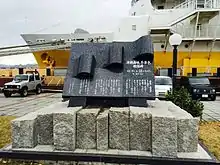Tsugaru Kaikyō Fuyugeshiki
"Tsugaru Kaikyo Fuyugeshiki" (津軽海峡・冬景色 Tsugaru Strait - Winter Scene) is the 15th single[1] and signature song by Japanese singer Sayuri Ishikawa. The song is written by Yu Aku as lyricist and Takashi Miki (三木たかし) as composer and arranger. The song sold over 727,000 units.[2][3]
| "Tsugaru Kaikyo Fuyu-geshiki" | ||||
|---|---|---|---|---|
 | ||||
| Single by Sayuri Ishikawa | ||||
| from the album Hana Kuyou –Sanbyaku Rokuju Go Nichi Koi Moyou | ||||
| B-side | "No no Hana no Youni" | |||
| Released | January 1, 1977 | |||
| Genre | Kayōkyoku, Enka | |||
| Length | 3:43 | |||
| Label | ||||
| Songwriter(s) | Yu Aku, Takashi Miki | |||
| Sayuri Ishikawa singles chronology | ||||
| ||||

The single was released on 1 January 1977 by Nippon Columbia. Together with “Amagi-goe”, the song is Ishikawa's most popular from her career. The hit of this song resulted in Ishikawa's first nomination for the Nippon Record Taisho Award (Japan Record Award 日本レコード大賞) in 1977 but she did not win the award.[4] In the same year, she appeared as a contestant to the annual NHK Kōhaku Uta Gassen for the first time in her career. As of 2018, Ishikawa has sung Tsugaru Kaikyo Fuyugeshiki ten times at the NHK Kōhaku Uta gassen.
Tsugaru Kaikyo Fuyugeshiki originally appeared as the song representing the month of December in Ishikawa's concept album titled Hana Kuyou –Sanbyaku Rokuju Go Nichi Koi Moyou and was not intended for single release. Prior to the release of the album, Ishikawa sang the song on stage at her recital in Osaka. This first presentation of the song received critical acclaim, which led to the song's subsequent release as a single in the following year.[5]
There is a monument commemorating the song at the Aomori Port in Aomori Prefecture alongside one of the retired Seikan Renraku-sen (青函連絡船) ferry ships Hakkoda-maru (八甲田丸), which is now converted into a Seikan Ferry museum.
“Tsugaru Kaikyo Fuyugeshiki” is referred to as the Ryojo Sanbu-saku (旅情三部作 Itinerary Song Trilogy) together with “Noto Hanto” (能登半島) and “Danryu” (暖流), the two other songs written by Yu Aku and Takashi Miki and released as singles in the same year 1977.[6]
Other versions
Ishikawa has re-recorded Tsugaru Kaikyo Fuyugeshiki for her remix album Shuto (秋冬) released in 1999 by Pony Canyon. This version is used as the concluding track of Ishikawa's 10-disk cover album and box set “Wonderful 20th century songs” [7] and is also included in the 40th anniversary box set released by Teichiku in 2012.[8]
Ishikawa has recorded an alternate version of the song by using Ichigo Ichie[9] as accompaniment in 2004. This version is included in an album titled “Teichiku Hour –Ichigo Ichie” released by Teichiku.[10]
B-side
The B-side song “No no Hana no Youni” (野の花のように Like a Wildflower) is written by Yu Aku as lyricist and Takashi Miki as composer and arranger. The sleeve has 4:17 as time of the song. The song was written for Ishikawa's recital at Osaka's Shin Kabuki-za Theatre (新歌舞伎座) 1976.[11]
Album inclusion
“Tsugaru Kaikyo Fuyu-geshiki” is included in Ishikawa's studio album “Hana Kuyou (Sanbyaku Rokuju Gonichi Koi Moyou)”. The B-side song “No no Hana no Youni” is not included in any of Ishikawa's studio albums but is included in the live recording album of her recital at Shin Kabuki-za.[12]
Personnel
Minoru Aono (青野稔) is credited as photographer for the cover. Columbia Recording Orchestra is credited for both songs.
Covers
Teresa Teng covered the song in the original Japanese[13][14] as well as in Chinese under the title '一片落葉' ('A Fallen Leaf').[15][16]
Other uses
The song appeared as the character song for Heiwajima Shizuo in the anime Durarara!!, sung by Ono Daisuke, on the DRRR Wrapping!! Character Song Collection compilation.[17][18]
Notes
- Nippon Columbia AK-43.
- "Oricon sale history of Sayuri Ishikawa" (in Japanese). Oricon. Archived from the original on May 24, 2011. Retrieved March 27, 2019.
- [oricon.co.jp "Official Oricon website"] Check
|url=value (help) (in Japanese). Oricon. Retrieved March 27, 2019. - Ishikawa did not win the Japan Record Award but won the Singer’s Award. (Official web page for the 19th Japan Record Award Archived 2014-04-07 at the Wayback Machine, viewed March 26, 2014).
- The live recording of the recital (Nippon Columbia AZ 7056-7). Also, The Record Vol. 638 (January 2013) at page 12, published by Recording Industry Association of Japan (RIAJ).
- The 1977 supplement to Heibonsha World Encyclopedia under the entry "Ishikawa Sayuri" (石川さゆり). Also, an interview of Ishikawa by ZAKZAK, viewed March 29, 2014.
- Teichiku TECS-20391-20400.
- Teichiku TECS-10511-15.
- Ichi-go ichi-e 一五一会, a musical instrument invented in 2003 and resembling both guitar and shamisen 三味線 is used as accompaniment.
- Teichiku TECN-25948.
- From the single’s sleeve.
- Nippon Columbia AZ 7056-7.
- https://www.universal-music.co.jp/teresa-teng/products/upcy-7214/
- https://www.youtube.com/watch?v=AQ-3olh6rZU
- https://www.discogs.com/%E9%84%A7%E9%BA%97%E5%90%9B-%E5%B3%B6%E5%9C%8B%E4%B9%8B%E6%83%85%E6%AD%8C%E7%AC%AC%E5%85%AD%E9%9B%86-/release/6524504
- https://www.youtube.com/watch?v=qS-28vdw6BM
- Aniplex SVWC-7837
- https://vgmdb.net/album/31361